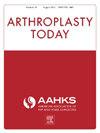Predictive Factors for Return to Driving After Lower Limb Arthroplasty
IF 2.1
Q3 ORTHOPEDICS
引用次数: 0
Abstract
Background
A common question post total hip arthroplasty (THA)/total knee arthroplasty (TKA) arthroplasty is “Doctor, when can I drive?”. No objective assessment currently exists. This study aimed to identify clinical factors predicting driving return post hip THA and TKA.
Methods
In this single-center retrospective observational study, patients were reviewed at 6 weeks post THA and TKA. Patient demographics, driving status, timed up and go (TUG) test, self-reported walking time (SRWT), walking aid use, and pain scores were collected. Descriptive statistics, t-tests, and binary regression models were used.
Results
Five hundred ninety two participants were included: 271 THA (males n = 134, mean age: 66.4) and 321 TKA (males n = 155, mean age: 66.8). THA: At 6 weeks, 155 patients (57.1%) were driving and 116 did not drive (DND) (n = 82 female, 70.6%) (P < .001). SRWT was longer in driving group (mean 36.35 minutes vs 31.23 minutes [P = .072]). TUG tests were faster in driving group (9.51 seconds vs 11.98 seconds [P < .001]). Driving inability predictors included using 2 crutches (P < .001) and TUG (P = .015). TKA: At 6 weeks, 196 patients (61%) were driving and 125 DND (n = 78 female, 62.4%) (P < .01). SRWT was longer in driving group (mean 33.6 vs 28.1 minutes [P = .31]). TUG tests were faster in driving group (10.18 seconds vs 12.29 seconds [P < .001]). Driving inability predictors included “severe” pain scores (P ≤ .0001) and >2 walking aids use (P = .022).
Conclusions
Following THA/TKA, 60% patients were driving by 6 weeks. Females take longer for driving return. Walking aids negatively impacted driving return, while faster TUG test and longer SRWT were positive predictors.
下肢关节置换术后恢复驾驶的预测因素
背景全髋关节置换术(THA)/全膝关节置换术(TKA)术后最常见的问题是“医生,我什么时候可以开车?”目前没有客观的评估。本研究旨在确定预测髋关节全髋关节置换术和全髋关节置换术后复发的临床因素。方法在这项单中心回顾性观察研究中,对THA和TKA后6周的患者进行回顾。收集患者人口统计资料、驾驶状况、计时行走(TUG)测试、自我报告的步行时间(SRWT)、助行器使用情况和疼痛评分。采用描述性统计、t检验和二元回归模型。结果共纳入592例患者,THA 271例(男性134例,平均年龄66.4岁),TKA 321例(男性155例,平均年龄66.8岁)。THA: 6周时,155例(57.1%)患者开车,116例(DND)患者不开车(n = 82, 70.6%) (P <;措施)。驾车组SRWT更长(平均36.35分钟vs 31.23分钟[P = .072])。驾驶组TUG测试速度更快(9.51秒vs 11.98秒)[P <;措施])。驾驶能力丧失预测因子包括使用2根拐杖(P <;.001)和TUG (P = .015)。TKA: 6周时,196例患者(61%)驾车,125例患者(n = 78例女性,62.4%)(P <;. 01)。驾驶组SRWT更长(平均33.6 vs 28.1分钟[P = .31])。驾驶组的TUG测试速度更快(10.18秒vs 12.29秒)[P <;措施])。驾驶能力丧失的预测因子包括“严重”疼痛评分(P≤0.0001)和使用>;2助行器(P = 0.022)。结论THA/TKA术后6周内,60%的患者能正常驾驶。雌性需要更长的时间才能返回。助行器负向影响驾驶回报,而更快的TUG测试和更长的SRWT是正向预测因子。
本文章由计算机程序翻译,如有差异,请以英文原文为准。
求助全文
约1分钟内获得全文
求助全文
来源期刊

Arthroplasty Today
Medicine-Surgery
CiteScore
2.90
自引率
0.00%
发文量
258
审稿时长
40 weeks
期刊介绍:
Arthroplasty Today is a companion journal to the Journal of Arthroplasty. The journal Arthroplasty Today brings together the clinical and scientific foundations for joint replacement of the hip and knee in an open-access, online format. Arthroplasty Today solicits manuscripts of the highest quality from all areas of scientific endeavor that relate to joint replacement or the treatment of its complications, including those dealing with patient outcomes, economic and policy issues, prosthetic design, biomechanics, biomaterials, and biologic response to arthroplasty. The journal focuses on case reports. It is the purpose of Arthroplasty Today to present material to practicing orthopaedic surgeons that will keep them abreast of developments in the field, prove useful in the care of patients, and aid in understanding the scientific foundation of this subspecialty area of joint replacement. The international members of the Editorial Board provide a worldwide perspective for the journal''s area of interest. Their participation ensures that each issue of Arthroplasty Today provides the reader with timely, peer-reviewed articles of the highest quality.
 求助内容:
求助内容: 应助结果提醒方式:
应助结果提醒方式:


